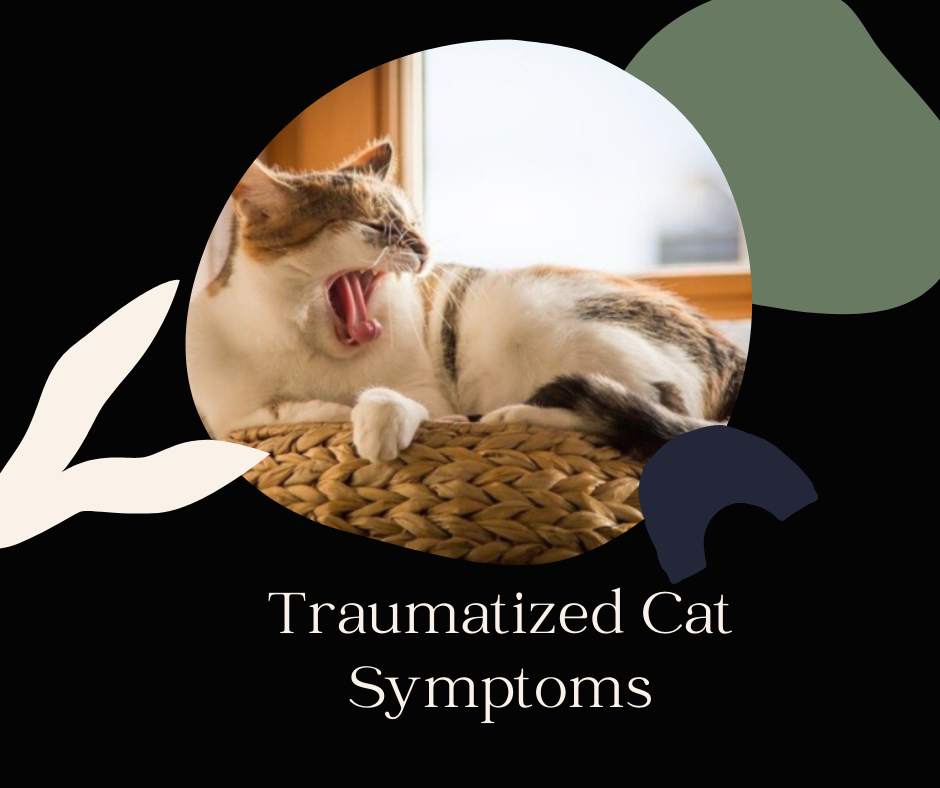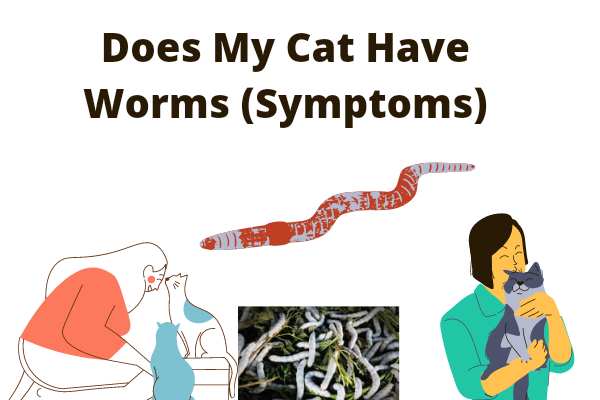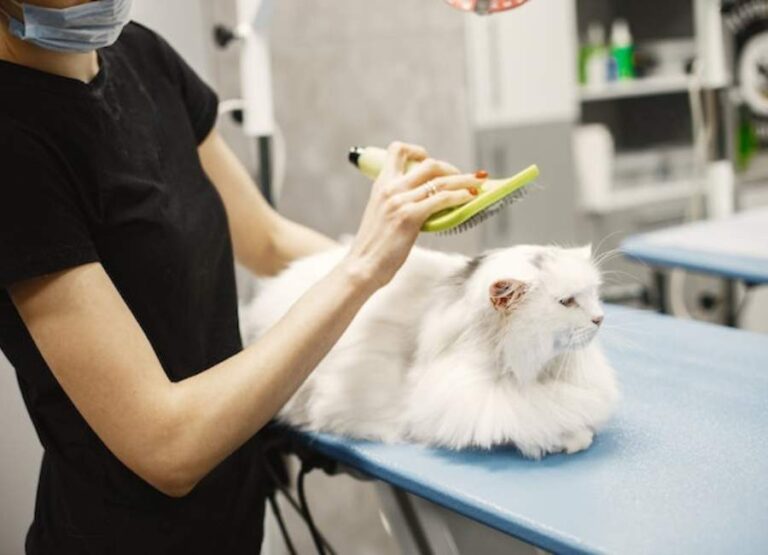14 Most Common Traumatized Cat Symptoms & Tips

People ask about traumatized cat symptoms a lot and in this article, we will outline all the symptoms of a traumatized cat.
Traumatized cats are difficult to handle, this is because they exhibit behaviors that make you wonder if they are still cats or some sort of wild animal.
When handling a traumatized cat you have to be careful.
Handling a traumatized cat should be something you stay in contact with your vet all the time.
Always call the vet when you notice a new behavior when dealing with a traumatized cat.
After listing the symptoms we will also touch causes of cat trauma.
Also, see how to help a cat adjust to a new home.
Common Traumatized Cat Symptoms
Here are all the symptoms associated with a traumatized cat;
1. Sleeping Disturbances
This is one of the most common traumatized cat symptoms you can see in a cat, as it will prove the cat is having a hard time.
Whether the cat is sick or the cat is having issues with the spot, type, or size of his bed it will affect his sleeping habits.
Cats are intelligent animals that remember a lot, and once they have a horrible experience it’s not always easy to forget.
Therefore, if your cat is having sleep disturbances, try to find out the root cause as it may be associated with a traumatic experience.
Maybe your cat was attacked while sleeping in the past or your cat had issues associated with a bed or position of sleeping.
2. Increased Hiding Behavior
Hiding is a normal thing for most cats, because during the day when everywhere is noisy and hot a cat always sneaks out and hides to take an afternoon nap.
This afternoon nap is either taken on top of shelves, in the basement, under a bed, in the backyard, behind furniture, at the top of cat trees, in parking stores, etc.
It’s normal for a cat to hide when the house is noisy or hot but is not normal for a cat to keep hiding even when everywhere is calm and the owner is around and calling the cat.
When a cat keeps hiding even when there is nothing to hide that cat is going through a traumatic experience, and at this point, such a cat needs the help of the owner and the vet.
Dealing with a traumatized cat should be the job of your vet unless stated otherwise by your vet.
So when you notice increased hiding behavior with your cat, kindly contact your vet.
Also look out when your cat is constantly in avoidance of people, places, and things that remind them of the trauma.
3. Changes In Temperaments
Every cat has unique temperaments or characteristics associated with them, but a traumatic experience could force a cat to change.
For example, if Ragdoll cats are not aggressive then you adopted one from anywhere just to find out the Ragdoll became aggressive in your new home.
Especially if the cat becomes unnecessarily aggressive when it comes to a particular activity or object.
This is definitely a sign of traumatic experience with such events or objects
4. Constant Agitation And Fear
If a cat is always panicking or agitated over any object, spot, or activity, then it is a clear sign the cat has had a horrible experience with that spot or object.
However, to observe this you must pay close attention to which activity or object initiated the fear or agitation.
One of the basic ways to help the cat is to seek help or stop such activities or events as well as avoid such spot
5. Constantly Attempting to Escape
A traumatized cat will always be attempting to escape because of some traumatic experience.
An indoor cat wanting to go outside is normal, maybe you have not properly socialized your indoor cat.
What is not normal is your cat wanting to escape even when you have made the cat comfortable, or the cat attempting to jump heights just to escape from home.
Most traumatized cats attempting to escape will end up hurting themselves, just like a human’s traumatic experience may end up giving you reasons for not wanting to live.
The best way to handle a traumatic cat is to take your cat to the vet.
6. Constantly Refusing to Eat
Refusing to eat a particular food and wanting another food is normal in most cats.
But what is not normal is a cat refusing to touch or get close to any food.
A cat can refuse food when sick, but if the cat is not sick, and it keeps saying no to every food you bring both wet and dry food that attracts the cat, then it is wise to check with your vet.
Refusing food is a clear symptom of your cat’s traumatic experience or that your cat is sick, so you need to pay attention to both.
7. Increased Aggressive Behavior
Being aggressive over food or toys is normal because every cat passes this stage of its life.
We as cat owners help correct this aggression at the kittens’ stages.
But what is not normal is a cat becoming more aggressive towards everything unnecessarily, even when you try to provide everything the cat needs to be happy.
When a cat suddenly becomes more aggressive than the usual you have experienced as a cat owner, it is wise you see a vet.
Or you just got a new cat and the cat keeps getting aggressive as the day goes by, you need to see a vet.
Or you came home and find out that your cat is no longer calm and collected as usual, if all efforts to calm your cat down are not working out, it is wise you see your vet.
8. Constantly Avoiding You or Other Pets
When a cat is traumatized the cat feels all alone in its world and will always want to be alone thereby avoiding any sort of contact with humans or other pets.
This is why you see cats hiding and not looking straight into the owner’s eyes when being called, a traumatized cat will not want to be with you and will always not answer when you call.
This avoidance behavior is actually the root cause of a traumatized cat trying or wanting to escape and die.
9. Constantly Freezing or Fidgeting
A traumatized is always fidgeting and freezing when it is not necessary.
Cats are calm pets that feel at home once you show them love and care.
Cats are also pets that remember a past event a lot, so if you get a new cat, and you are sure you carried out all the medical exams and the cat is still freezing or fidgeting, it’s wise to see your vet.
10. Constantly Pawing At You
Repeatedly pawing at the owner is a sign that your cat is trying to pass information to you, but as we know cats cannot talk.
Over the years of experience with cats, we and other cat owners have observed that when a cat repeatedly paws at the owner such cat is complaining, and you need to pay attention.
If after you have tried to make your cat comfortable and the cat is still pawing at you repeatedly, you need to talk to an experienced vet.
We have explained the basic symptoms, and that is not to say there are no other symptoms, but we consider them secondary.
11. Excessive Vocalization
When a cat becomes unnecessary vocal than it use to be then something is definitely wrong somewhere, so always look out for when a can is constantly been vocal.
Traumatic experiences can change the way cats see their new or old environment which can prompt them to become unnecessarily vocal.
12. Constantly Panting And Pacing
Constant panting, howling and pacing can sometimes be attributed to a past traumatic event, that directly or indirectly affected the cat.
Normally, cat panting or pacing is not something serious to worry about, but as a cat continues it even when it is not necessary, it becomes a problem.
This can occur during a specific activity, either on the sight of an object or other animals, or even sound. This shows a traumatic experience.
13. Refusing to Use Litter Box
Refusal to use the litter box is a clear indication that something is not right and cats are very prone to traumatic experiences.
If you have tried and your cat is still not using the litter box then you should consider changing the litter box or the position.
You can confirm that either your cat won’t like the litter box by getting a new litter box, your cat is sick, or it’s a traumatic experience by changing the position of the box.
The litter box may be associated with a traumatic experience if the cat is always running away from it.
Or a specific color or size, or design. So try to watch and see if your cat is not using it because of size or color.
14. Constantly Puffing Fur And Tail
Puffing fur or tail unnecessarily is not a good sign in cats, as it can sometimes be associated with traumatic experiences like fighting with another cat.
Puffing of fur or tail is something that is normal in cats for many reasons, but what is not normal is when it is associated with an event.
Pay close attention to what is currently going on when your cat puffs its fur, and repeat the activities or events.
If the cat continues then it’s associated with a traumatic experience, and you need to stop such activities.
Learn more about why cats sleep so much.
Causes of Trauma In Cats
Generally, trauma in cats is caused by bad experiences from the past that keeps reoccurring in the mind of a cat.
There are so many causes of trauma in cats, but we will outline some of the most popular and common ones.
Here are what causes trauma in cats;
- Household accidents
- Abuse from owners
- Jumps from heights that resulted in injury
- A fatal fight between the cat and a bigger animal
- Escaping from human traps
- Car Accident
- Escaping death from a predator’s jaws
- Hunger
- Neglect from loved ones
- Exposure to toxins
- Bad experience with the vet
How To Fix A Traumatized Cat
The following are some common ways to fix a traumatized cat:
- Provide a safe and secure environment for your cat. This may mean setting up a quiet space for them to retreat to or providing hiding places throughout the home.
- Establish a routine for feeding and playtime. This can help your cat feel more secure and in control.
- Provide plenty of positive reinforcement and affection. This can help your cat feel more comfortable and confident.
- Make sure your cat has plenty of opportunities for exercise and play.
- Use pheromone products that can help reduce stress and anxiety.
- Consider using medication to help manage your cat’s anxiety, under the guidance of a veterinarian.
- Avoid punishing your cat for any unwanted behavior, as this can exacerbate anxiety and fear.
- Try desensitizing and counter-conditioning your cat.
- Consider seeking the help of a professional animal behaviorist or trainer.
- Be patient and understanding. It may take time for your cat to recover from trauma and regain their confidence and trust in humans.
Learn more about why your cat is hiding and not eating.
Common ways to prevent trauma in cats
Here are some common ways to prevent trauma in cats:
- Keep cats indoors: Keeping cats indoors reduces the risk of being hit by cars, attacked by other animals, or getting lost.
- Take precautions during car trips: When traveling with cats, always use a carrier to keep them safe and secure.
- Provide a safe environment: Make sure your home environment is free from hazards such as sharp objects, toxic plants, or dangerous household chemicals.
- Regular vet check-ups: Regular check-ups can help identify any health issues that could lead to trauma. Also, ensure your cat receives all the necessary vaccinations.
- Spay or neuter your cat: Spaying or neutering can prevent certain types of behavior, such as wandering and fighting, which can lead to trauma.
- Supervision during outdoor activities: When letting your cat outdoors, always supervise and make sure they are not wandering too far from home.
- Protect your cat from other animals: If you have other pets, make sure they are safely introduced to your cat to prevent any aggressive behavior.
- Provide regular exercise: Exercise is important for cats to maintain a healthy weight, and can also prevent injuries from becoming overweight or obese.
- Regular grooming: Regular grooming can help identify any issues such as ticks, fleas, or skin problems that could lead to infection, which may require medical attention.
Learn more about adopted stray cat behaviors.
Frequently Asked Questions
What are some physical signs that my cat may be traumatized?
Physical symptoms of trauma in cats can include lethargy, loss of appetite, changes in litter box behavior, and excessive grooming or licking of their fur.
Can traumatize cats show changes in behavior?
Yes, cats that have experienced trauma may exhibit changes in their behavior, including aggression, avoidance, and hiding.
They may also be more vocal than usual or show a lack of interest in activities they previously enjoyed.
Learn more about ways cats show affection.
Is it possible for my cat to have PTSD?
Yes, post-traumatic stress disorder (PTSD) can affect cats just as it can affect humans.
Cats with PTSD may exhibit symptoms such as hyperarousal, hypervigilance, and avoidance behaviors.
How can I help my cat if they are exhibiting symptoms of trauma?
If you suspect that your cat may be traumatized, it’s important to provide a safe and secure environment for them.
You may also want to consult with a veterinarian or animal behaviorist to develop a treatment plan.
Can cats develop anxiety as a result of trauma?
Yes, cats can develop anxiety as a result of trauma. Cat anxiety symptoms may include restlessness, increased heart rate, and dilated pupils.
Can cats recover from trauma?
With proper care and treatment, cats can recover from trauma.
It may take time and patience, but providing a calm and loving environment and working with a veterinary professional can help traumatized cats heal and regain their confidence.
Conclusion
In conclusion, if you suspect that your cat is experiencing any of the traumatized cat symptoms we’ve discussed, it’s important to seek veterinary care as soon as possible.
With patience, love, and proper treatment, your furry friend can recover from their trauma and live a happy, healthy life.
Remember to always be observant of your cat’s behavior and provide them with a safe and comfortable environment.
With your support, your cat can overcome their trauma and thrive.






